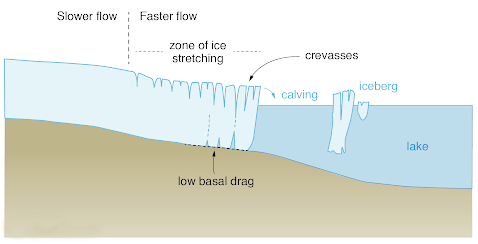Geography
Iceberg A68a
- 28 Dec 2020
- 6 min read
Why in News
Iceberg A68a, which calved from Antarctica in 2017, has been floating off the coast of South Georgia island.
- This has prompted fears about the impact the iceberg could have on the island’s abundant wildlife.
Key Points
- Iceberg:
- An iceberg is ice that broke off from glaciers or shelf ice and is floating in open water.
- Icebergs travel with ocean currents and either get caught up in shallow waters or ground themselves.
- The US National Ice Center (USNIC) is the only organisation that names and tracks Antarctic Icebergs.
- Icebergs are named according to the Antarctic quadrant in which they are spotted.
- A68a:
- Shaped like a closed hand with a pointing finger, the iceberg known as A68a split off in 2017 from Larsen Ice Shelf on the West Antarctic Peninsula, which has warmed faster than any other part of Earth's southernmost continent.
- On its journey, smaller icebergs have calved from the iceberg and the biggest section of the iceberg is called A68a and spans an area of roughly 2,600 sq. km.
- Recently, the two icebergs that calved from A68a - have been named by the USNIC. They are called A68e and A68f.
- All the berg fragments are entrained in a fast-moving stream of water known as the Southern Antarctic Circumpolar Current Front.
- The Antarctic Circumpolar Current (ACC) is the most important current in the Southern Ocean, and the only current that flows completely around the globe.
- The ACC, as it encircles the Antarctic continent, flows eastward through the southern portions of the Atlantic, Indian, and Pacific Oceans.
- It has been drifting towards the remote island of South Georgia, which is a British Overseas Territory (BOT).
- The fear is that if the iceberg grounds itself near the island, it could cause disruption to the local wildlife that forages in the ocean. Penguins and seals will have to travel farther in search of food.
- On the other hand, there are some positives of an iceberg being stuck in the open ocean, since icebergs carry dust which fertilises ocean plankton, which draws up carbon dioxide from the atmosphere.
- The British Antarctic Survey (BAS) will launch a research mission to study A68a’s impact on the ecosystem.
- BAS is a component of the Natural Environment Research Council (NERC). NERC is part of UK Research and Innovation.
- It delivers and enables world-leading interdisciplinary research in the Polar Regions.
Calving of Glaciers
- Meaning:
- Calving is the glaciological term for the mechanical loss (or simply, breaking off) of ice from a glacier margin.
- Calving is most common when a glacier flows into water (i.e. lakes or the ocean) but can also occur on dry land, where it is known as dry calving.
- Process:
- Before calving occurs, smaller cracks and fractures in glacier ice grow into larger crevasses.
- The growth of crevasses effectively divides the ice into blocks that subsequently fall from the snout into an adjacent lake (where they are known as icebergs).
- Glacier Snout: It is the lowest end of a glacier, also called glacier terminus or toe.
- Impact on Glacier Mass Balance:
- In lake-terminating (or freshwater) glaciers, calving is often a very efficient process of ablation and is therefore an important control on glacier mass balance.
- Ablation: It implies combined processes (such as sublimation, fusion or melting, evaporation) which remove snow or ice from the surface of a glacier or from a snow-field.
- Glacier mass balance: It is simply the gain and loss of ice from the glacier system.
- In lake-terminating (or freshwater) glaciers, calving is often a very efficient process of ablation and is therefore an important control on glacier mass balance.
- Global warming has increased the frequency of this process.
- Recent Cases of Calving:
- Up to the end of the 20th century, the Larsen Ice Shelf had been stable for more than 10,000 years.
- In 1995, however, a huge chunk broke off, followed by another in 2002. This was followed by the breakup of the nearby Wilkins Ice Shelf in 2008 and 2009, and A68a in 2017.
- Hydrofracturing - when water seeps into cracks at the surface, splitting the ice farther down - was almost certainly the main culprit in each case.
- Hydrofracturing is a water well development process that involves injecting high pressure water via the well into the bedrock formation immediately surrounding it.
- It was originally developed for the oil and gas industry to increase oil and gas well production.
- On a global scale, drilling or hydrofracturing result in significant greenhouse gas emissions, leading to global warming.







